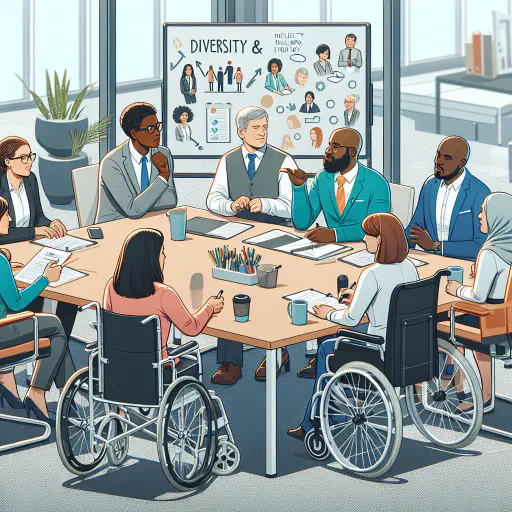
How to Design Effective Training Programs for Your Employees
After recognizing the pitfalls of ineffective training, this blog will equip you with actionable strategies to design impactful training programs that truly develop your employees’ skills. By reading this, you’ll benefit from insights that foster engagement, enhance performance, and align with your organizational goals, ensuring a worthwhile investment in your team’s growth.
Combining our understanding of why training programs often miss the mark with practical guidance, this blog promises a transformation in how you approach employee development. Expect to walk away with the knowledge to create tailored, engaging, and effective training programs that not only boost your employees’ capabilities but also drive your organization’s success.
1. Identifying Employee Training Needs
To craft an effective training program, first, delve into the specific requirements of your employees. This initial step is all about pinpointing the precise skills and knowledge lacking within your workforce that hampers their job performance.
Imagine you’re a detective looking for clues in job descriptions, performance metrics, and direct feedback from staff and managers. This can be achieved via surveys, one-on-one interviews, or thorough performance reviews—tools that act as your magnifying glass to reveal the hidden gaps.
For instance, let’s say the data shows a need for improvement in customer service skills; this insight can steer the training focus directly towards that area. Incorporating quotes from employees about their training experiences can add a personal touch and emphasize the necessity for a bespoke training and development program.
Remember, a well-targeted solution is more effective than a generic one, much like a key perfectly cut to fit a lock.
2. Setting SMART Learning Objectives for Training Success
Crafting SMART objectives is like setting the GPS for your training journey – it ensures you reach the desired destination efficiently and effectively. Let’s take “improving customer service skills” as an example. Transform this into a Specific objective by focusing on enhancing communication and problem-solving skills. To make it Measurable, set a target, such as reducing customer complaints by 20%.
Ensure it’s Achievable by providing the right resources and support. The goal should be Relevant to the employees’ roles and the company’s customer satisfaction targets. Lastly, make it Time-bound by establishing a three-month period to achieve the improvements. Including quotes from industry experts on the value of SMART goals can add credibility and inspire your team.
Remember, well-defined objectives are the stepping stones to your program’s success – they guide your efforts, motivate your employees, and facilitate the evaluation of training effectiveness.
3. Tailoring Training Content to Employee Needs
To ensure that training resonates with employees, it’s vital to tailor the content to their specific professional backgrounds and learning styles. One way to achieve this is by incorporating industry-specific examples that the employees can relate to, such as those from a digi training and development institute or a right training and career development center. Case studies, particularly from well-regarded training and development centers, can serve as powerful teaching tools.
For instance, a scenario drawn from the kids wania international training and skill development center could provide practical insights into addressing common workplace challenges. Additionally, using quotes from experts within the industry or testimonials from past participants of training and development certification programs in Ajman can add credibility and context to the training.
By highlighting key takeaways through callouts or text highlights, trainers can draw attention to the most critical pieces of information, making the learning experience more effective and memorable. Remember, the goal is to make the training as relevant and engaging as possible so that employees can see the direct benefit to their roles, which in turn supports the importance of training and development in the broader context of human resource management (HRM).
4. Selecting the Right Delivery Method for Training Content
Selecting the right delivery method for your training content is like finding the perfect pair of shoes for a marathon; it can make all the difference in performance and satisfaction. Imagine an e-learning module on the intricacies of training and development in HRM that uses interactive simulations to demonstrate real-world scenarios. This approach not only caters to those who learn best through visual and hands-on experiences but also allows employees to fit training into their busy schedules.
Or consider an in-person workshop at your training and development center, where role-playing activities bring soft skills to life, fostering immediate feedback and collaborative learning. By highlighting specific anecdotes, like how the right training and career development center used blended learning to increase employee engagement, we provide concrete examples that resonate with the audience.
And let’s not forget the impact of testimonials from staff who’ve experienced the benefits first-hand, adding credibility and relatability to the training program. It’s about creating an accessible and engaging learning journey that aligns with both the diverse needs of your workforce and the strategic objectives of your organization.
5. Enhancing Training Engagement with Storytelling and Real-Life Scenarios
Incorporating storytelling and real-life scenarios is a transformative technique in training programs, bringing abstract concepts to life and fostering a deeper connection between employees’ work and the skills they are learning. By gathering anecdotes from staff, trainers can create scenarios that mirror the daily challenges employees face, making the training relatable and memorable.
For instance, a customer service training session could include a story from a colleague about a particularly difficult client interaction, followed by a group discussion on handling similar situations. This method not only makes the learning process more engaging but also serves as a platform for employees to share their experiences, adding a layer of peer learning.
Additionally, using case studies from the industry can provide a broader context, allowing employees to visualize the impact of their roles within the company’s ecosystem. Remember, a well-told story can be a powerful catalyst for learning, sparking curiosity, and encouraging employees to think critically about how they can apply new knowledge in their day-to-day activities.
6. Leveraging Technology for Interactive Learning
Integrating technology into employee training programs can revolutionize the learning experience, making it more interactive and engaging. For instance, incorporating multimedia presentations can bring content to life, making complex information more digestible for employees.
Imagine using virtual reality (VR) simulations to place staff in realistic scenarios where they can practice new skills in a safe environment. Additionally, gamification elements, like earning badges or points for completing training modules, can motivate employees by tapping into their competitive spirit.
An effective use of technology could involve a Learning Management System (LMS) that supports various multimedia content and tracks progress, ensuring that employees have a personalized and adaptable learning journey. By using these methods, training can cater to different learning styles and preferences, making the development process more enjoyable and effective. Remember, the goal is to create an active learning culture that not only educates but also excites and inspires your workforce.
7. Social Learning and Collaboration: The Power of Community in Employee Development
Social learning and collaboration are not just buzzwords; they are the bedrock of a thriving workplace culture. Imagine a training session where employees are actively discussing, debating, and sharing their insights – that’s the power of social learning. By setting up discussion forums, organizations can create a virtual space where employees exchange ideas, which can be particularly beneficial for staff training and development.
Consider the story of a Rak International Training and Development Center, where forums led to a breakthrough in project collaboration. Moreover, when we encourage peer-to-peer mentoring, we’re not just building skills; we’re fostering relationships that bolster the right training and career development center within the company.
Personal reflections from seasoned employees can serve as a lighthouse for newcomers, guiding them through uncharted professional waters. These authentic exchanges often prove more impactful than any training manual. And let’s not forget case studies; these real-life scenarios help cement the importance of training and development in HRM by showing the tangible outcomes of effective teamwork and shared learning.
By intertwining these elements, we create a dynamic environment where continuous learning is not just encouraged – it’s lived.
8. Support and Feedback for Effective Training
To truly embed new skills and knowledge, a robust support and feedback system is indispensable. Imagine an employee who has just completed a training session. Without proper coaching and access to supplementary resources, they might struggle to apply what they’ve learned. That’s why incorporating structured mentoring programs and follow-up workshops is so crucial.
These initiatives should be complemented by accessible online resources that employees can refer to at any time. It’s like giving them a safety net as they walk the tightrope of new responsibilities. Moreover, regular check-ins and feedback sessions are not just a safety measure; they act as a continuous dialogue between employees and trainers.
Consider this: a study indicated that 43% of highly engaged employees receive feedback at least once a week. This statistic highlights the power of feedback in maintaining employee engagement and ensuring the practical application of training. By creating an environment where feedback is frequent and constructive, we not only support our employees but also pave the way for continuous improvement and a culture of excellence.
9. Measuring Training Program Effectiveness and Impact
To truly appreciate the value of training and development, we must gauge its effectiveness. This process starts with setting clear benchmarks prior to the training and continues with a thorough analysis of performance metrics after. Imagine a scenario where an employee’s productivity shoots up by 20% post-training; this is a quantifiable sign of success.
Moreover, consider the story of a company that saw a marked increase in customer satisfaction ratings after their staff completed a communication skills workshop. By using a blend of assessments and surveys, we can paint a clear picture of the training’s impact.
It’s not just about ticking boxes; it’s about understanding the growth and progress of your team. Feedback and performance data together tell a compelling story, one that can guide future training and ensure a solid return on investment for the company. Encouraging this analytical approach empowers organizations to refine their training strategies continually, ensuring they stay relevant and results-driven.
10. Fostering a Culture of Continuous Learning
To build a thriving workplace, it’s essential to go beyond the occasional training session and cultivate a culture of continuous learning. Encouraging your employees to keep expanding their skills can be achieved through various strategies.
Maintaining a resource-rich learning library is one such strategy. This serves as a treasure trove of knowledge, offering the latest books, articles, and videos relevant to your industry. You can also introduce a reward system that acknowledges employees who hit learning milestones, such as completing certain training and development certification programs in Ajman.
Real-life examples like Rak International Training and Development Center show how integrating continuous learning into daily operations can significantly boost employee engagement and performance. By creating an environment where learning is valued and rewarded, you can help your team stay ahead of the curve, ready to tackle the evolving challenges of their roles.
This commitment to growth not only increases job satisfaction but also ensures your company remains competitive in a rapidly changing business landscape. In conclusion, the pathway to a successful and dynamic workplace is paved with the bricks of continuous learning. The challenge now lies with you – will you take the necessary steps to foster a culture of growth and development within your team? Don’t let the momentum stop here; I urge you to start small but start today.
Create a list of resources for your learning library, or design a simple, yet effective, reward system to celebrate educational accomplishments. Encourage your employees to set personal learning goals, and most importantly, lead by example. Show them that their growth is your priority by investing in their potential.
Remember, the investment you make in your employees’ development is an investment in the future of your company. Challenge yourself to be the catalyst for change, and watch as your team and your business transform together.


